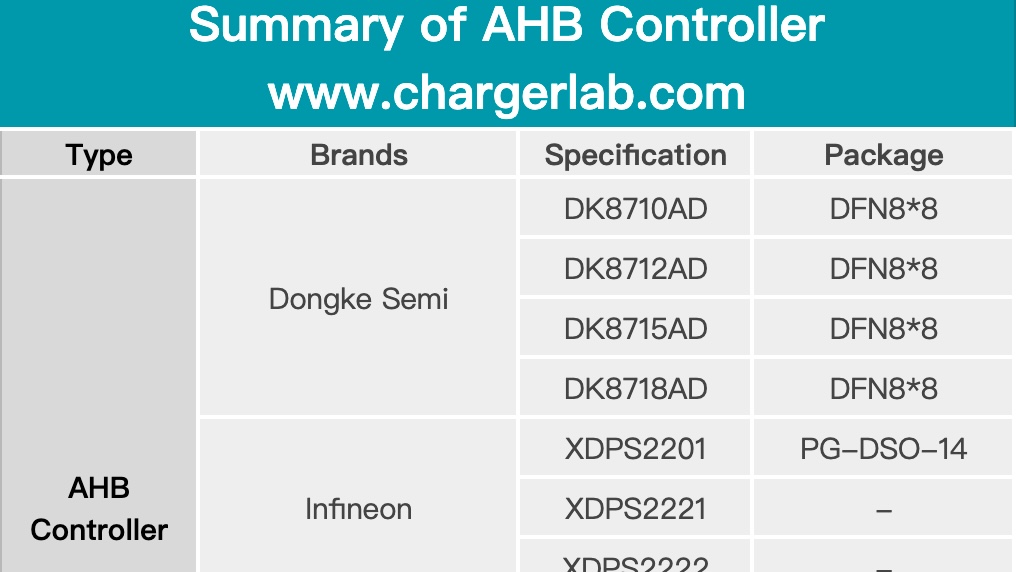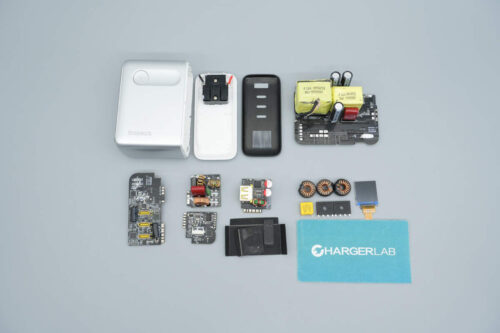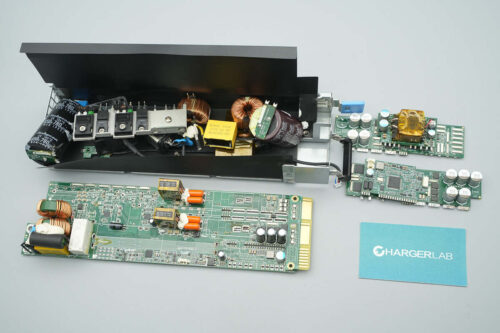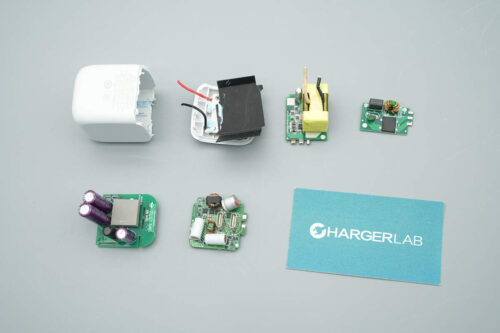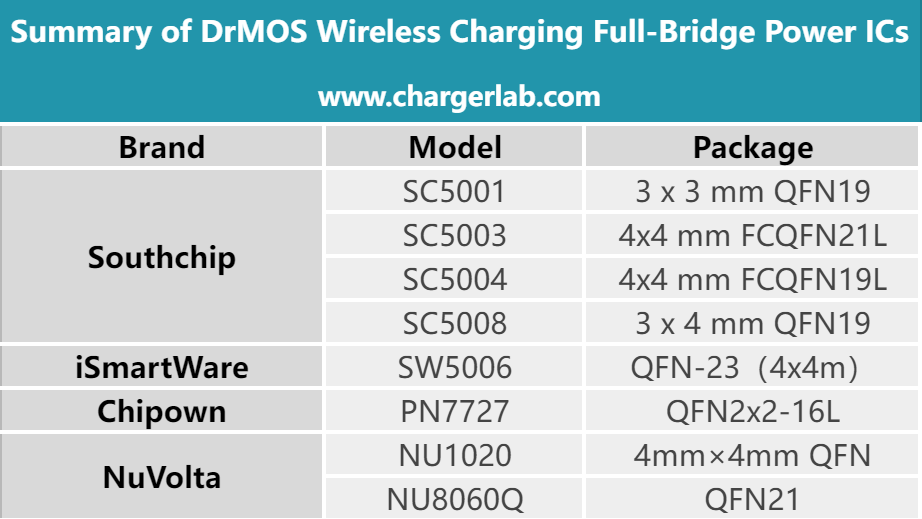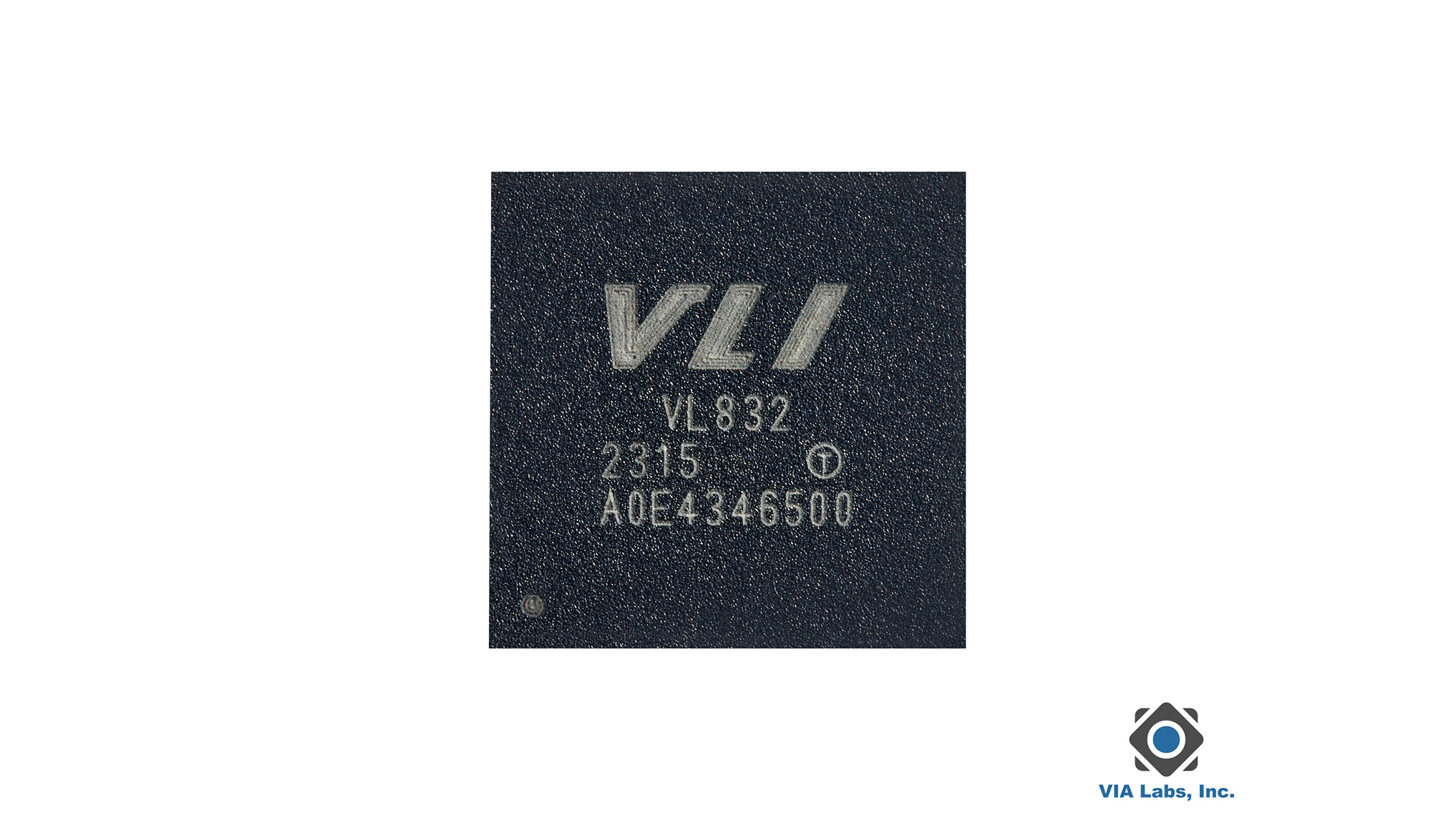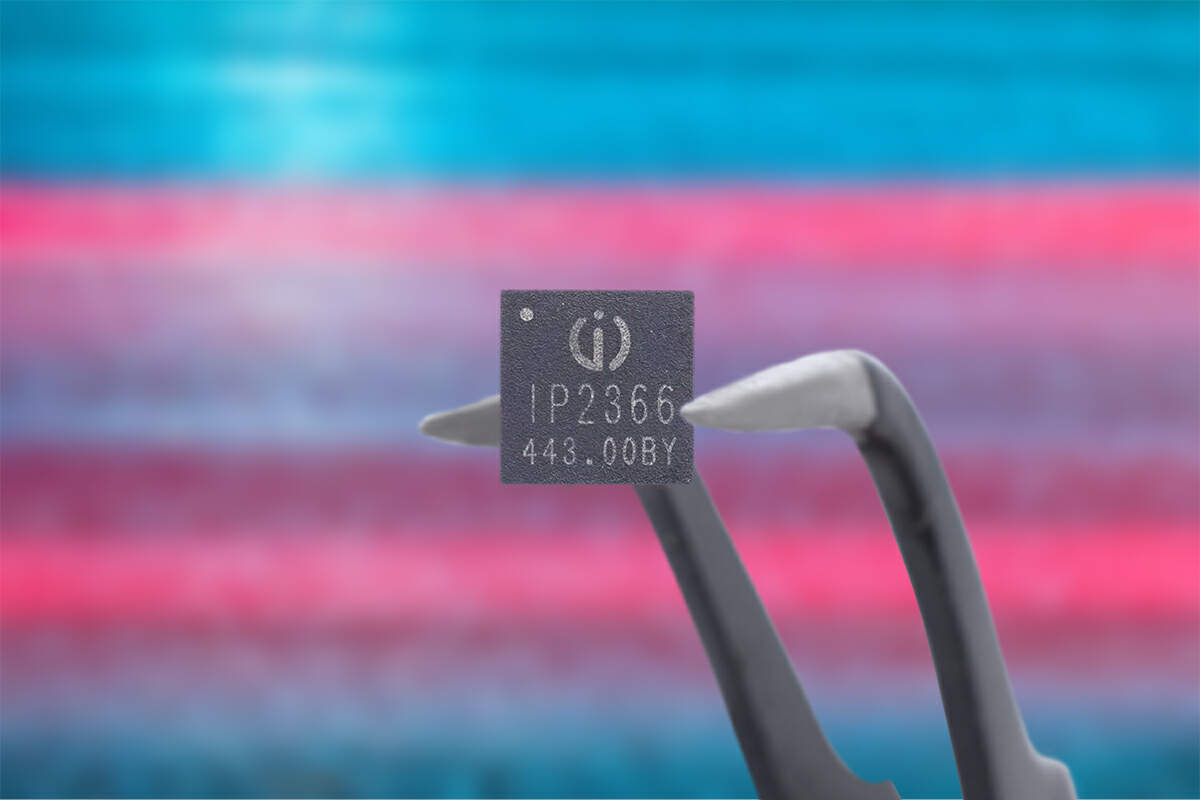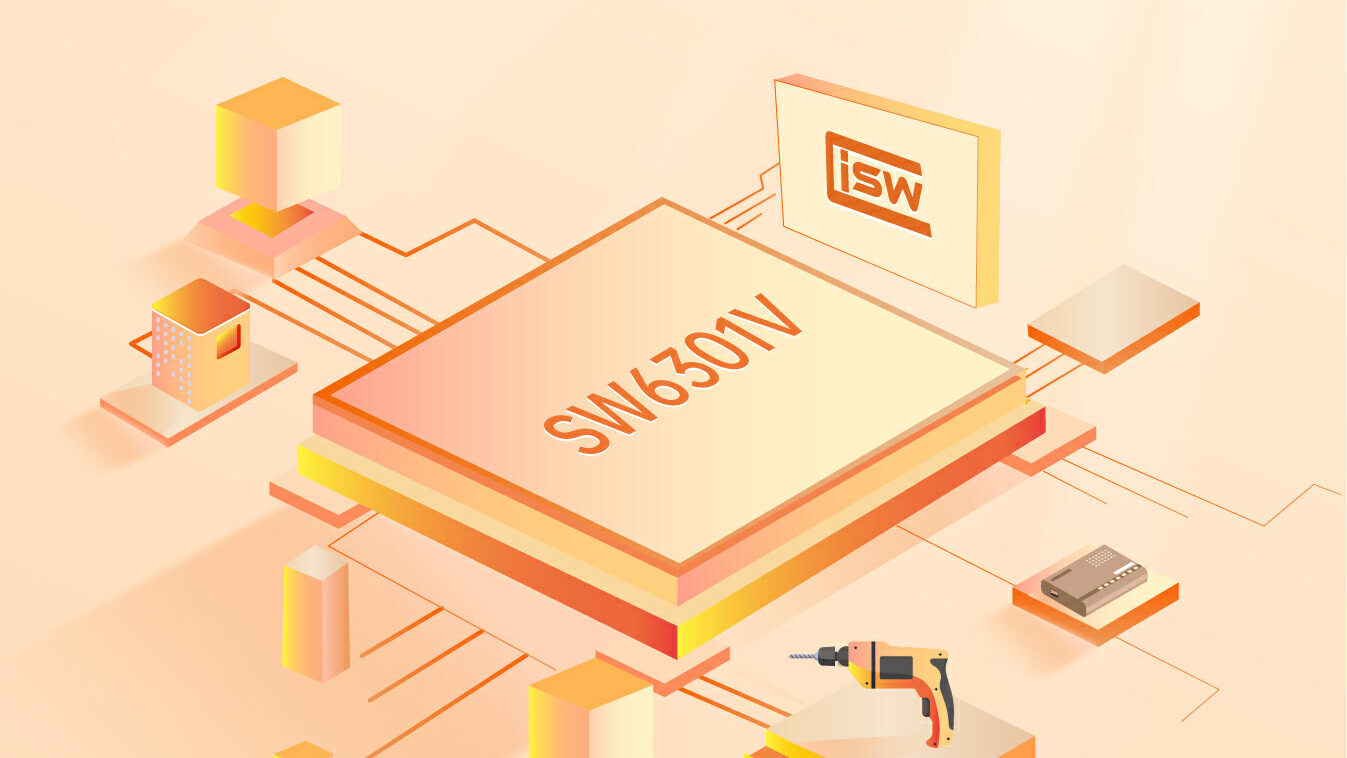Introduction
Nowadays, e-bike chargers are generally high-power. Many manufacturers have launched e-bike chargers equipped with AHB controllers. The AHB controller uses two MOSFETs to form a half-bridge and uses a capacitor in series with the primary coil of the transformer to store energy together. Through the newly added MOSFET, the capacitor energy is transferred to the secondary components through the transformer. Compared with the traditional flyback controller which consumes the transformer leakage inductance as heat, the AHB controller not only recycles the leakage inductance but also realizes zero-voltage switching of the main MOSFET and zero-current switching of the synchronous rectifier, reducing switching losses and heat generation.
What is an AHB Controller?
The AHB topology involves both the transformer excitation inductance and the resonant capacitor inside the asymmetric half-bridge in storing energy. Compared to the flyback converter, it reduces the volume to some extent. AHB combines the advantages of the flyback converter and the asymmetric half-bridge, utilizing the excitation current to achieve MOSFET ZVS (Zero Voltage Switching) and the resonant current to achieve secondary rectifier diode ZCS (Zero Current Switching). AHB is well-suited for wide voltage output applications, and in comparison to the LLC topology, it offers significant advantages in applications with wide output voltage variations like PD fast charging, providing substantial cost benefits. AHB's switching frequency is limited to a relatively narrow range, making it highly beneficial for EMI filter design. AHB is suitable for high power density and cost-effective topologies.
Compared to the LLC architecture, the AHB architecture has the following advantages. Firstly, the AHB architecture's secondary side is a single-power-device topology, effectively reducing system costs. Secondly, the AHB architecture places significantly lower voltage stress on secondary rectifier diodes compared to traditional flyback architectures, enabling the use of lower voltage-rated MOSFETs, which greatly reduces system costs and debugging complexity, especially in applications requiring high output voltage like PD fast charging. Thirdly, in the AHB architecture, the transformer and resonant capacitor jointly store energy, effectively reducing the size of the transformer.
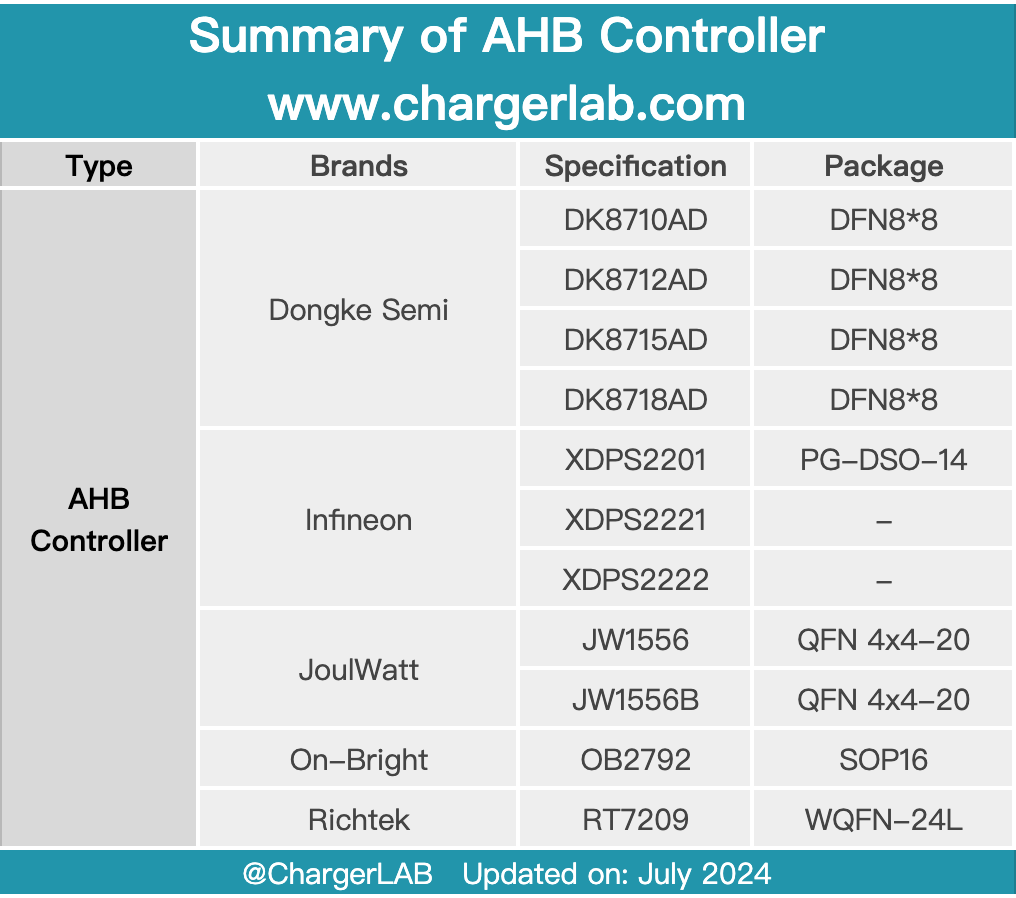
According to ChargerLAB's incomplete statistics, renowned industry manufacturers such as Dongke Semi, Infineon, JoulWatt, On-Bright, and Richtek have already introduced or are about to release new AHB controllers. Let's take a closer look at them.
The following manufacturers are listed alphabetically.
Dongke Semi
DK8710AD
DK8710AD is an AC-DC power switch IC based on an asymmetric half-bridge architecture and integrating two GaN FETs. It can effectively recycle leakage energy, achieve ZVS of the main FET and ZCS of the synchronous rectifiers, improve conversion efficiency, reduce power device stress, reduce switching losses, and enhance electromagnetic interference (EMI) performance.
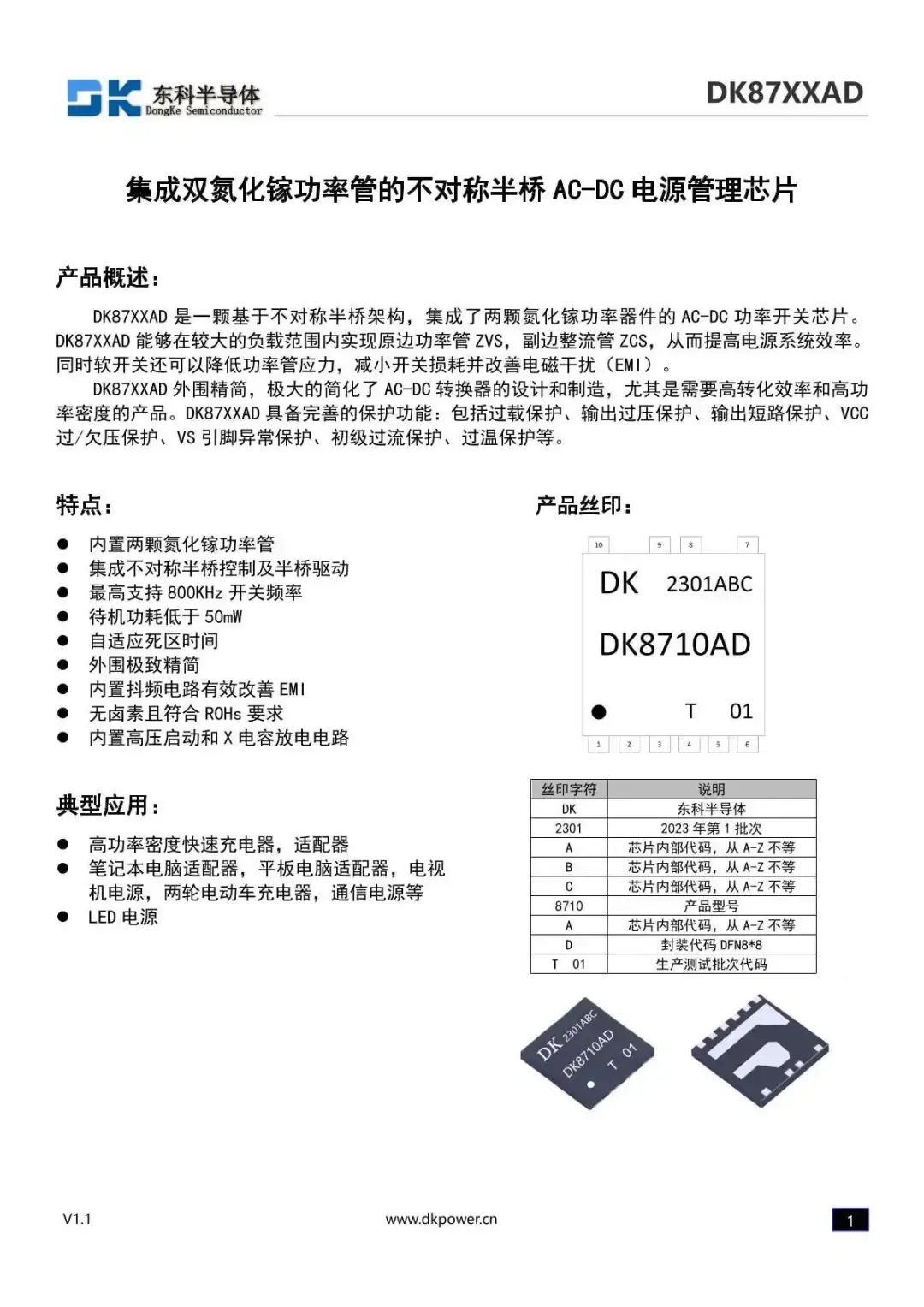
The DK8710AD has a reduced number of peripheral components, greatly simplifying the design and manufacturing of AC-DC adapters, especially products that require high conversion efficiency and high power density. It has complete protection functions: including overload protection, output overvoltage protection, output short circuit protection, VCC over/under voltage protection, VS pin abnormality protection, primary overcurrent protection, overtemperature protection, etc. It adopts DFN8*8 package. 365-480mΩ 100W.
DK8712AD
Compared with DK8710AD, the internal resistance of DK8712AD is further reduced to 270-350mΩ, and the recommended application power is 120W.
DK8710AD is an AC-DC power switch IC based on an asymmetric half-bridge architecture and integrating two GaN FETs. It can effectively recycle leakage energy, achieve ZVS of the main FET and ZCS of the synchronous rectifiers, improve conversion efficiency, reduce power device stress, reduce switching losses, and enhance electromagnetic interference (EMI) performance.
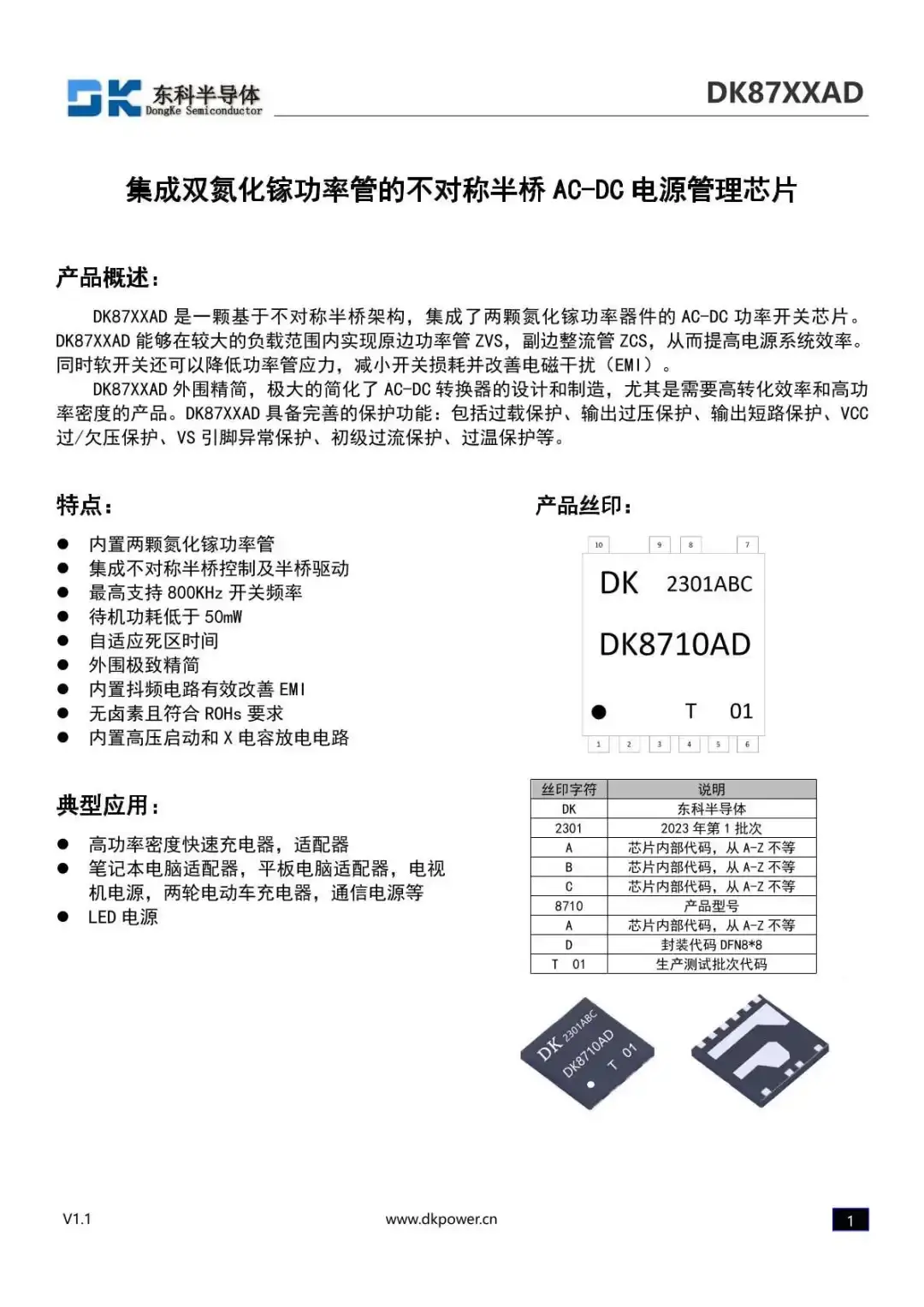
The DK8710AD has a reduced number of peripheral components, greatly simplifying the design and manufacturing of AC-DC adapters, especially products that require high conversion efficiency and high power density. It has complete protection functions: including overload protection, output overvoltage protection, output short circuit protection, VCC over/under voltage protection, VS pin abnormality protection, primary overcurrent protection, overtemperature protection, etc. It adopts DFN8*8 package.
DK8715AD
DK8715AD is an AC-DC power switch IC based on an asymmetric half-bridge architecture and integrating two GaN FETs. It can effectively recycle leakage energy, achieve ZVS of the main FET and ZCS of the synchronous rectifiers, improve conversion efficiency, reduce power device stress, reduce switching losses, and enhance electromagnetic interference (EMI) performance.
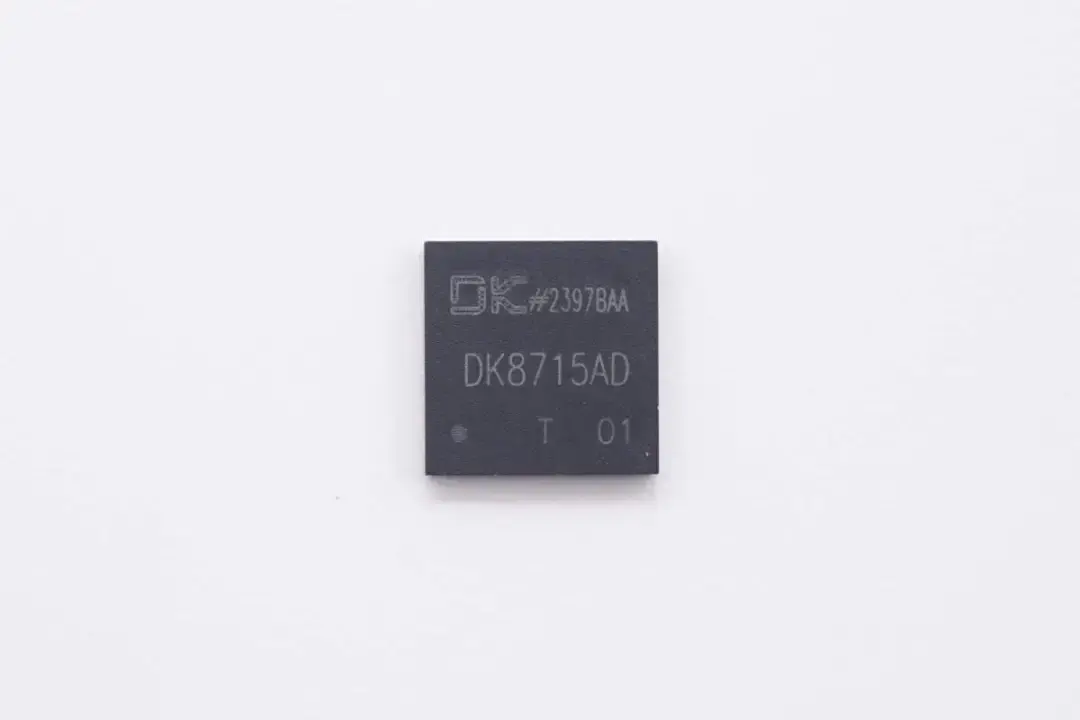
DK8715AD supports a maximum switching frequency of 800KHz, a standby power consumption of less than 50mW, and has an adaptive dead time. It is halogen-free, meets ROHs requirements, and has built-in high-voltage startup and X-capacitor discharge circuits, providing higher performance and reliability for the system.
DK8715AD has a reduced number of peripheral components, greatly simplifying the design and manufacturing of AC-DC adapters, especially products that require high conversion efficiency and high power density. It has complete protection functions: including overload protection, output overvoltage protection, output short circuit protection, VCC over/under voltage protection, VS pin abnormality protection, primary overcurrent protection, overtemperature protection, etc.
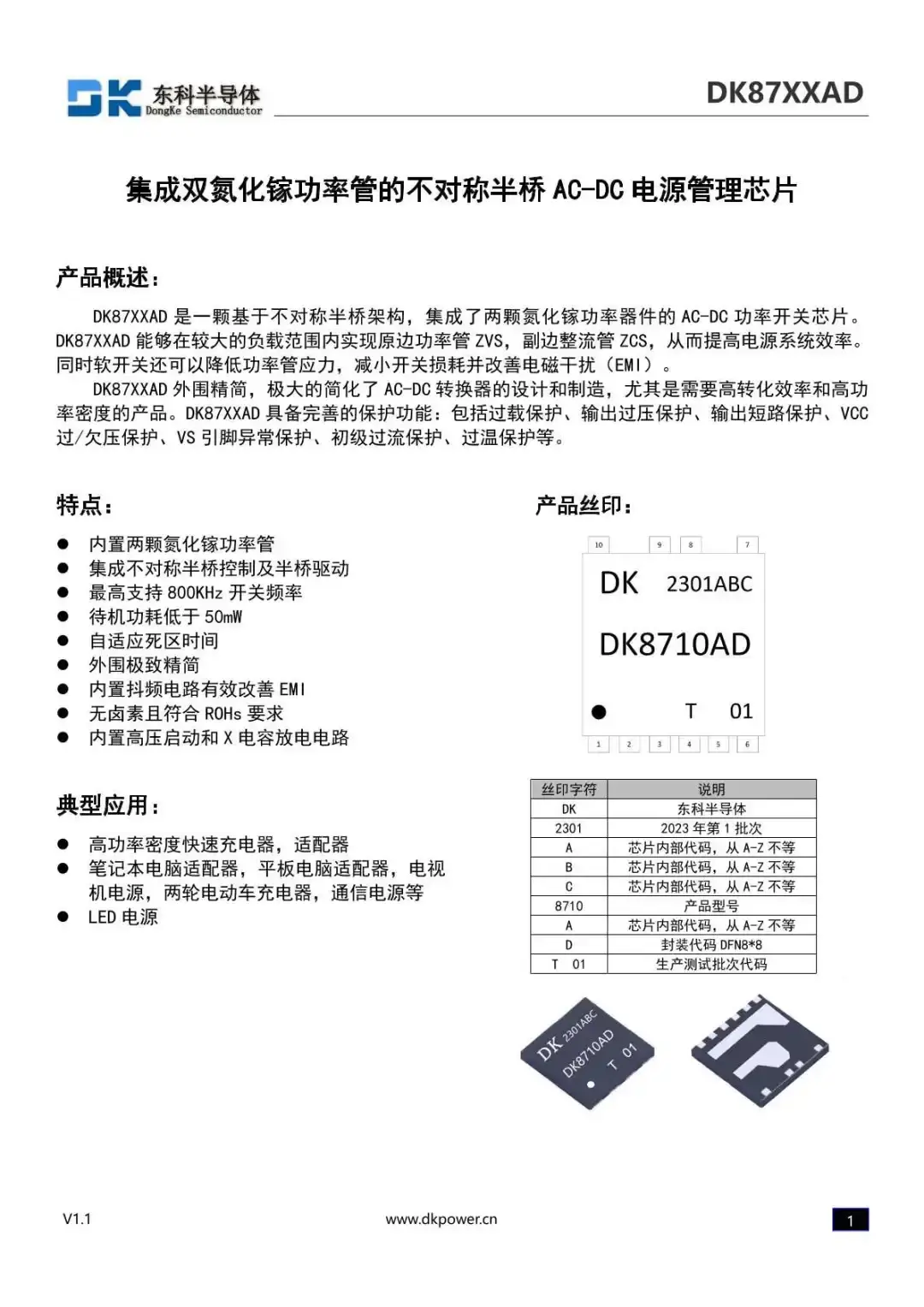
DK8715AD adopts DFN8*8 package. It is suitable for high power density fast chargers, adapters, laptop adapters, tablet chargers, TV power supplies, e-bikes, communication power supplies, LED power supplies, and other fields.
DK8718AD
Compared with DK8715AD, the internal resistance of DK8718AD is further reduced to 115-150mΩ, and the recommended application power is 180W.
DK8718AD is an AC-DC power switch IC based on an asymmetric half-bridge architecture and integrating two GaN FETs. It can effectively recycle leakage energy, achieve ZVS of the main FET and ZCS of the synchronous rectifiers, improve conversion efficiency, reduce power device stress, reduce switching losses, and enhance electromagnetic interference (EMI) performance.
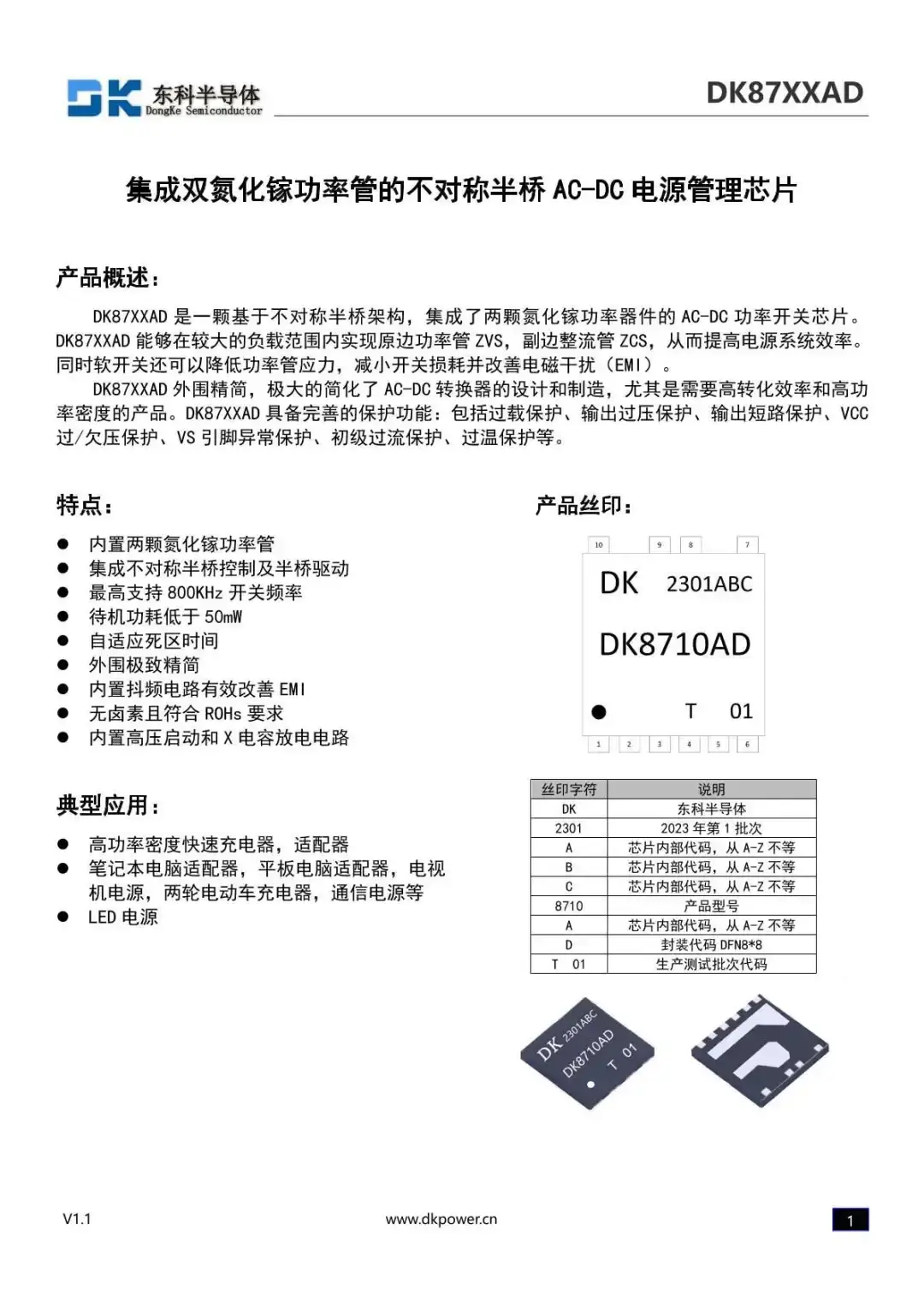
DK8718AD has a reduced number of peripheral components, greatly simplifying the design and manufacturing of AC-DC adapters, especially products that require high conversion efficiency and high power density. It has complete protection functions: including overload protection, output overvoltage protection, output short circuit protection, VCC over/under voltage protection, VS pin abnormality protection, primary overcurrent protection, overtemperature protection, etc.
Infineon
XDPS2201
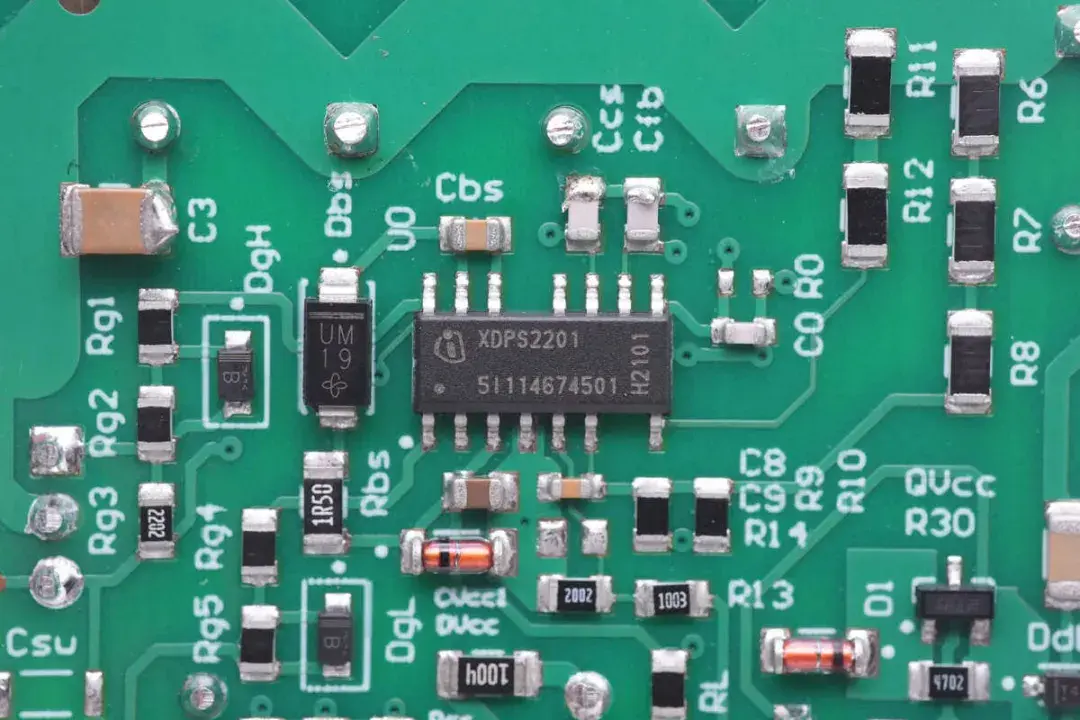
XDPSS2201 is a digital hybrid flyback controller. It integrates a 600V high-voltage start-up cell for fast charging. It can be used with IGI60F1414A1L GaN IC to provide customers with highly integrated, efficient, high-performance, and low-temperature rise GaN fast charging solutions.
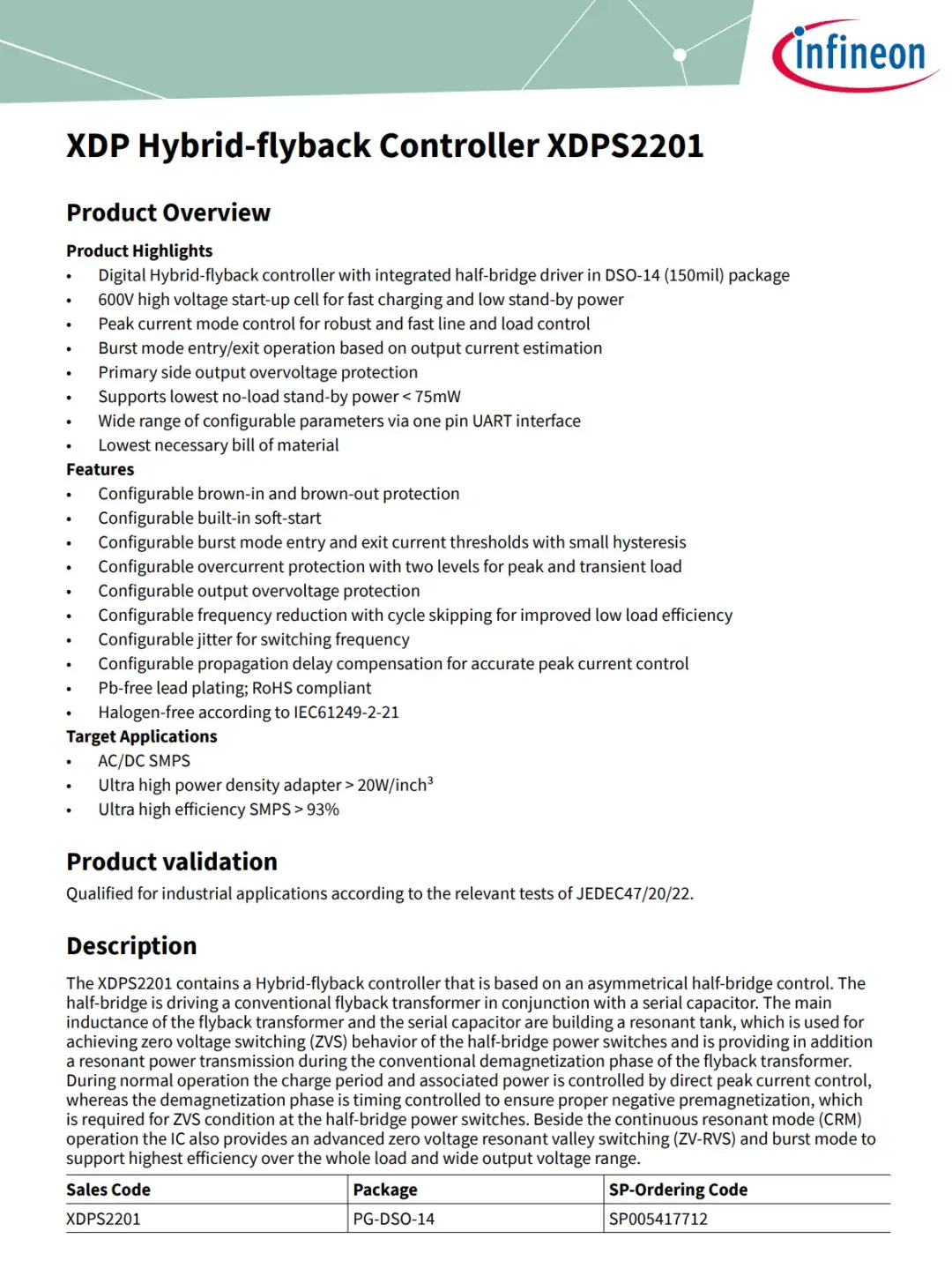
XDPSS2201 adopts peak current mode control for fast load response. It supports primary side overvoltage protection, and the standby power consumption is less than 75mW. It can be configured through a single-pin UART interface. It adopts PG-DSO-14 package.
XDPS2221
XDPS2221 is a new generation of PFC+HFB controller. It combines the PFC controller with the XDPS2201 HFB controller to help power supply manufacturers create a simpler, more efficient, and compact power supply design.
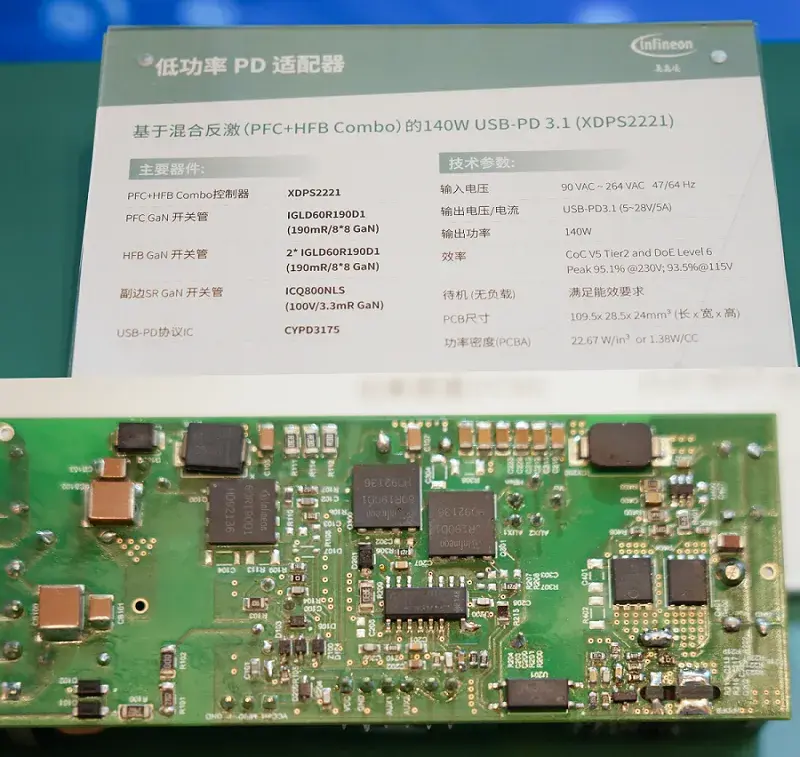
XDPS2221 supports a wide input range of 90~264Vac (47Hz/64Hz) PD3.1, and an input voltage of 5V-28V. The output current of it is 5A and the output power is 140W. The conversion efficiency reaches over 95% at 230V, and the 115V conversion rate reaches 93.5%, which meets the energy efficiency requirements and helps the development of PD power adapters with green energy efficiency requirements.
XDPS2221 packages the PFC controller and HFB controller together. It adopts three IGLD60R190D1 (190M ohm/8*8GaN) CoolGaN power components, one in the PFC GaN FET and the other two in the HFB GaN FET. The SR GaN FET model it uses is ICQ800NLS (100V/3.3mR). The USB-PD protocol power IC model is CYPD3175. The size of the PCB is only 109.5 x 28.5 x 24 mm (4.31 x 1.12 x 0.94 inches). The power density reaches 22.67W/In³ or 38W/CC. This design saves PCB area while bringing significant performance improvements, and can better adapt to various low-power PD adapter applications.
XDPS2222
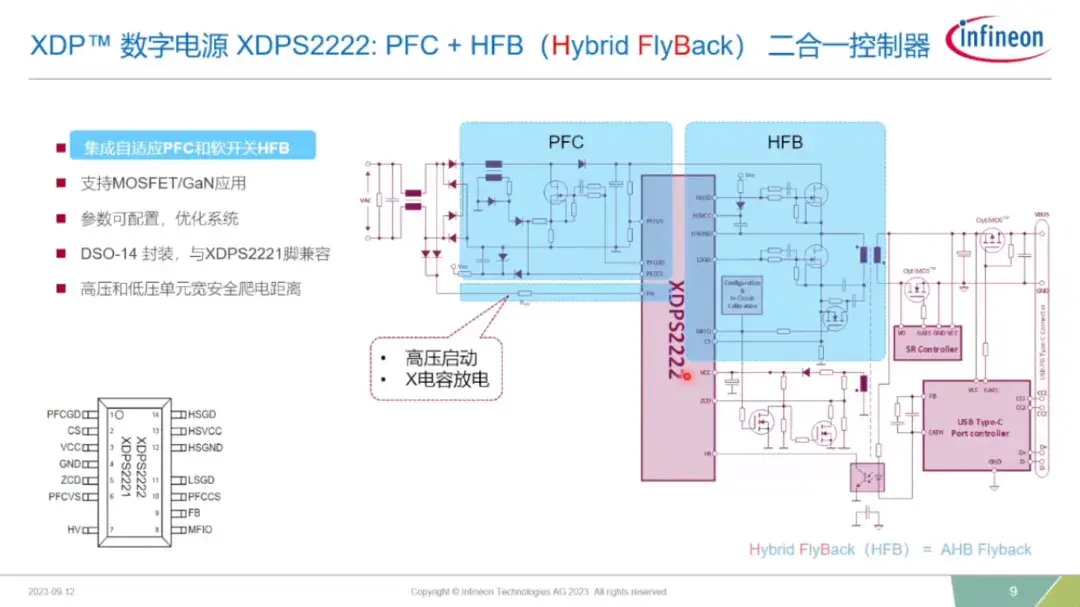
XDPS2222 has many upgrades and improvements compared to XDPS2221. It supports a wide output voltage range of 5~48V for USB-PD3.1 applications, especially suitable for applications such as high power density fast chargers, laptop adapters, and e-bike chargers. The PFC function that is adaptively adjusted according to input and output can significantly improve the average efficiency and meet the latest energy efficiency standards. The HFB controller provides an innovative resonant capacitor switching function to greatly meet the design of a wider output voltage range and further improve efficiency.
JoulWatt
JW1556
JoulWatt JW1556 is an asymmetric half-bridge flyback controller, packaged in QFN4x4-20, suitable for offline flyback converter applications. It has an input voltage range of 2.5-38V, a maximum operating frequency of up to 1.5MHz, and supports fast charging applications ranging from 65W to 300W.
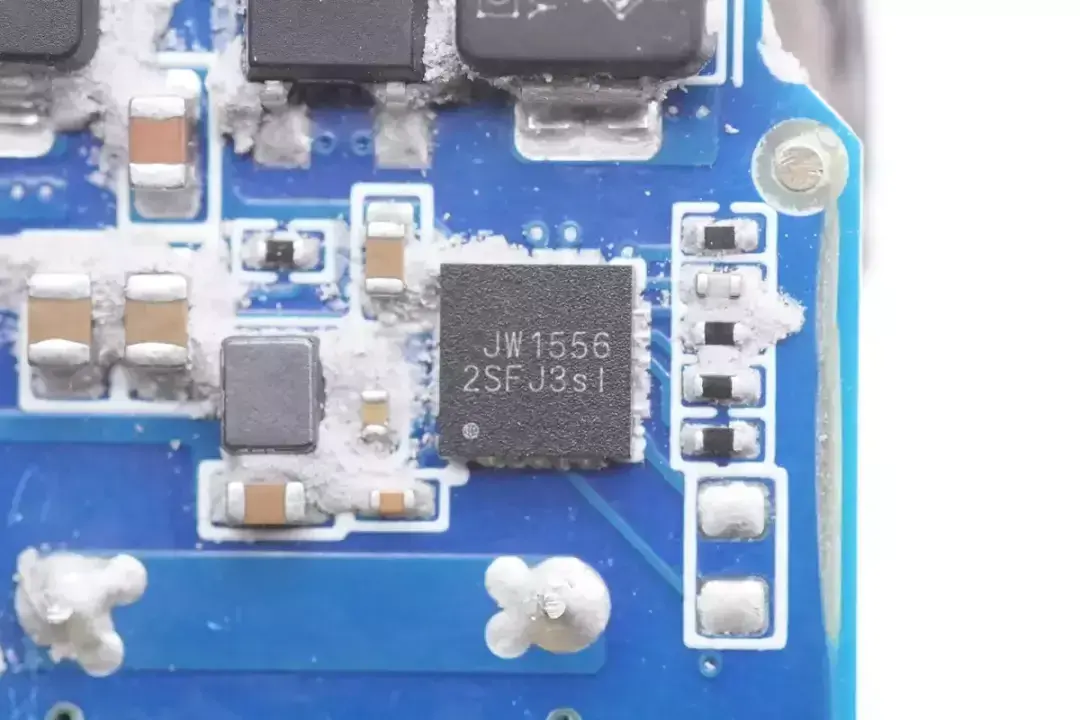
JW1556 can set the operating frequency through a single external resistor, keeping the design simple with minimal peripherals. The chip includes soft start, VIN OVP, VS OVP, SCP, Brown-In/Out, OTP, CS open circuit, and short circuit protection, enhancing the reliability of the power supply system. It can also provide charger manufacturers with a one-stop solution for PD 3.1 applications.
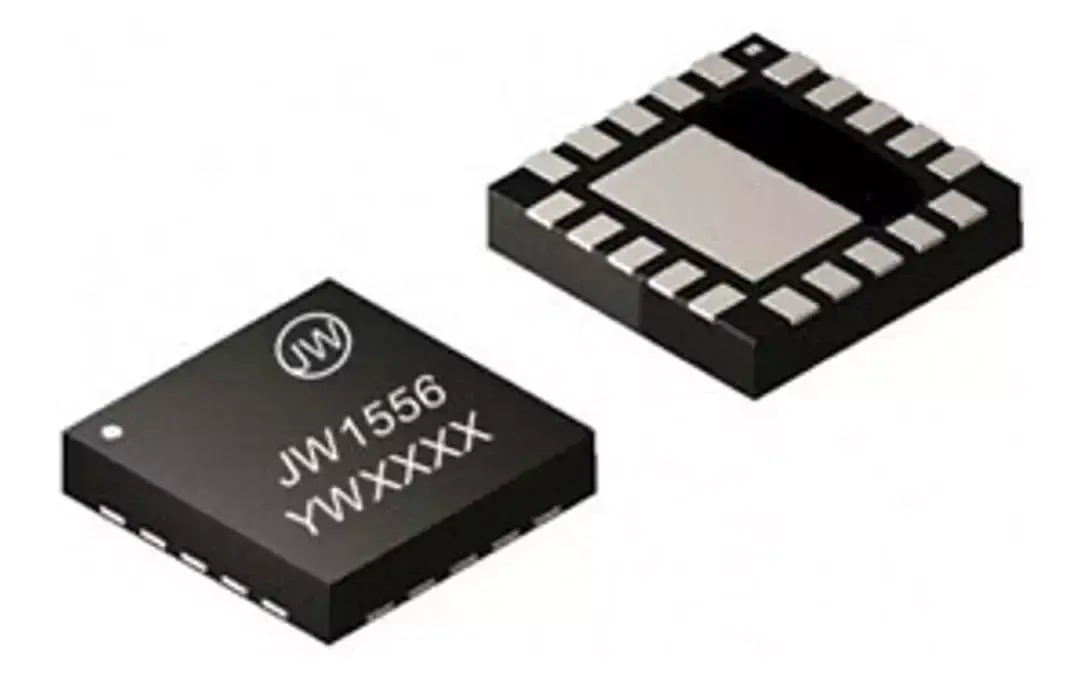
It operates in ZVS mode under heavy loads, supports Adaptive ZVS, and optimizes efficiency. Under light loads, it operates in DCM mode, providing primary and auxiliary switch control, high-voltage start-up, X capacitor discharge control, burst mode control, adjustable line compensation, and other features. It is used to support various usage scenarios of chargers and maximize efficiency.
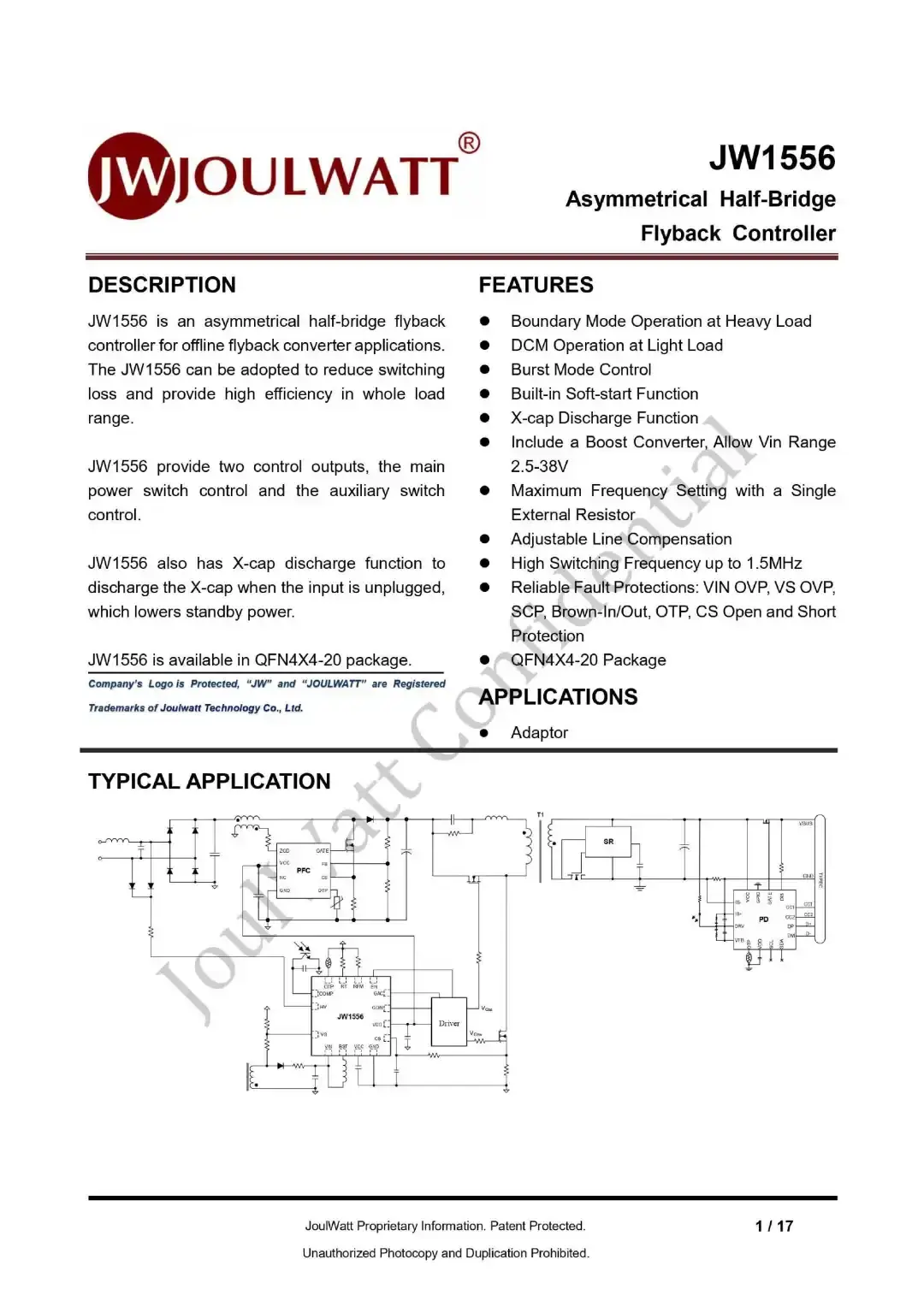
Here is all the information about the JoulWatt JW1556.
JW1556B
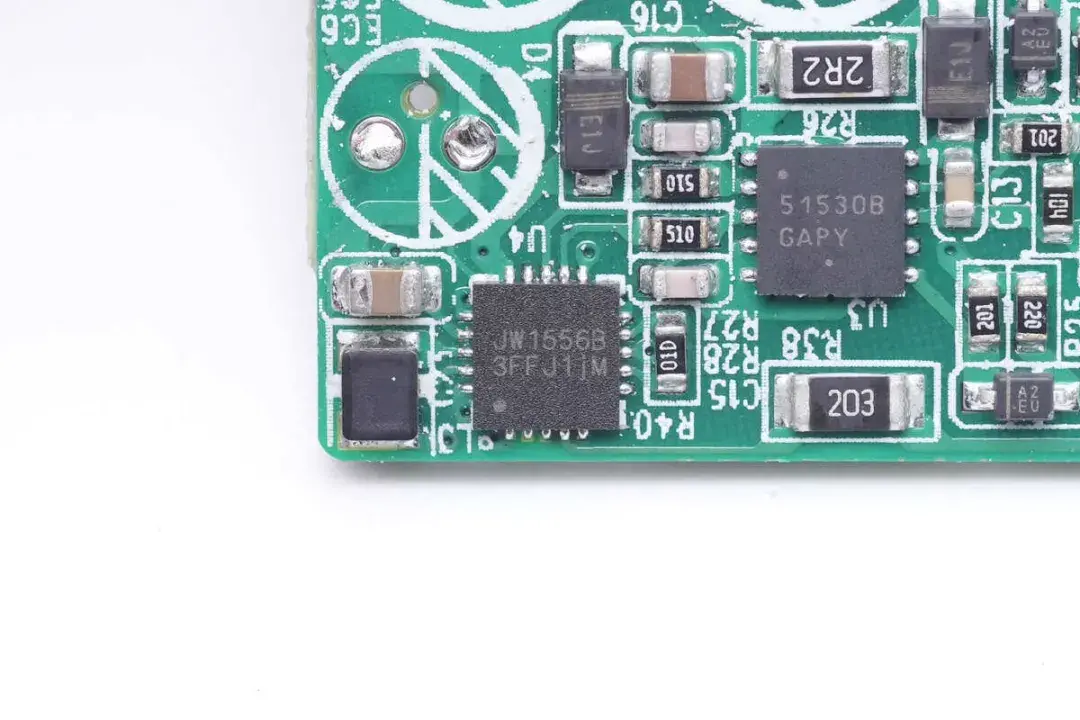
JW1556B is an optimized model by JoulWatt for peak load scenarios, supporting a wide input voltage range of 0-38V. It is suitable for the laptop market, which demands 1-2 times peak power.
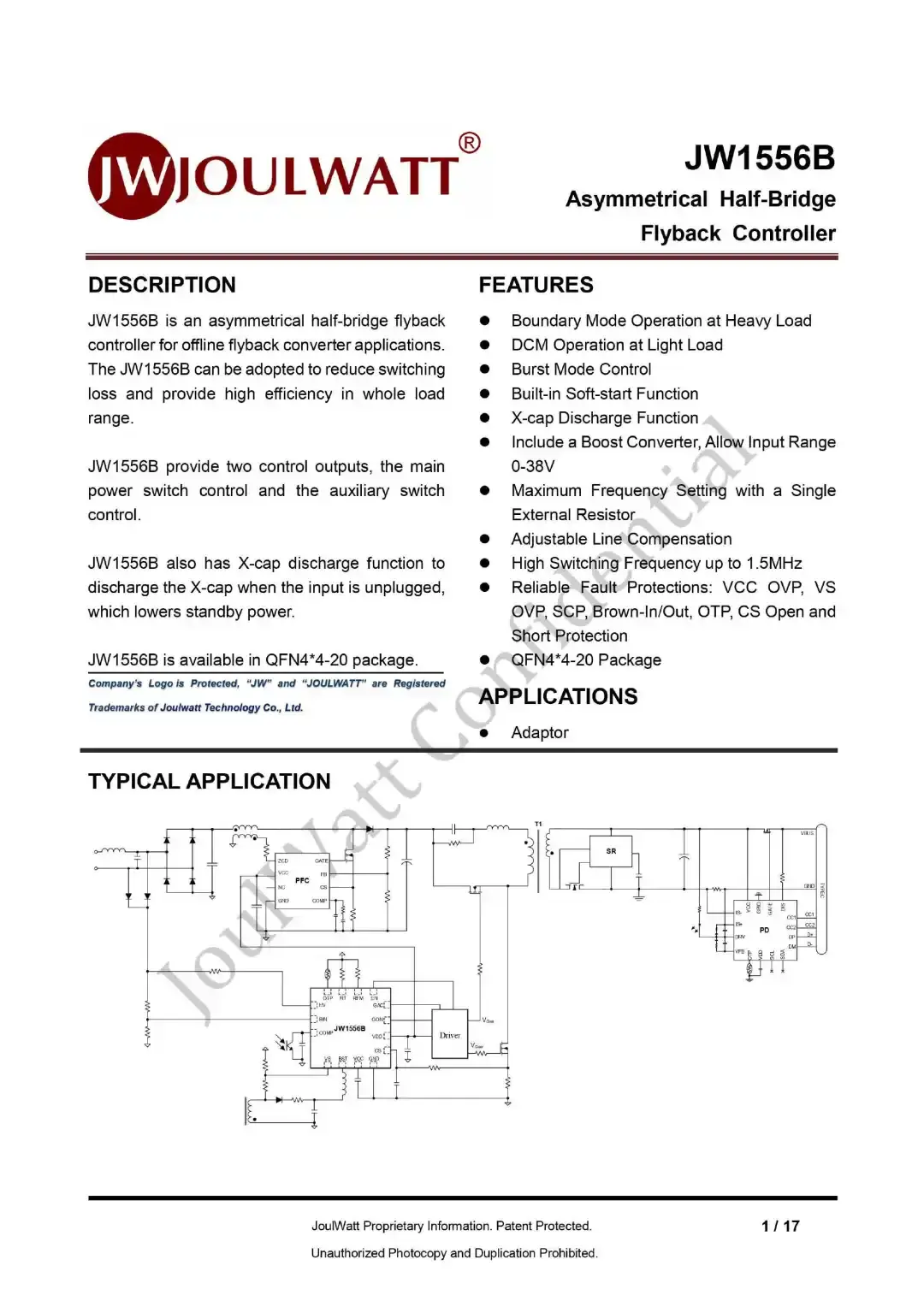
Many key features of JW1556B are the same as JW1556, such as QFN4x4-20 packaging and a maximum operating frequency of 1.5MHz, as well as support for high-voltage start-up, X capacitor discharge control, burst mode control, adjustable line compensation, and more.
On-Bright
OB2792
On-Bright OB2792 is an AHB controller designed for zero-voltage switching resonant converters. Under normal operation, the high-side charging cycle employs conventional peak current control, while the low-side turn-on cycle is regulated by an internal adaptive control loop. Under heavy loads, the chip operates in continuous resonant mode, while under light loads, it enters a frequency foldback mode, achieving zero-voltage switching and reducing switching losses.
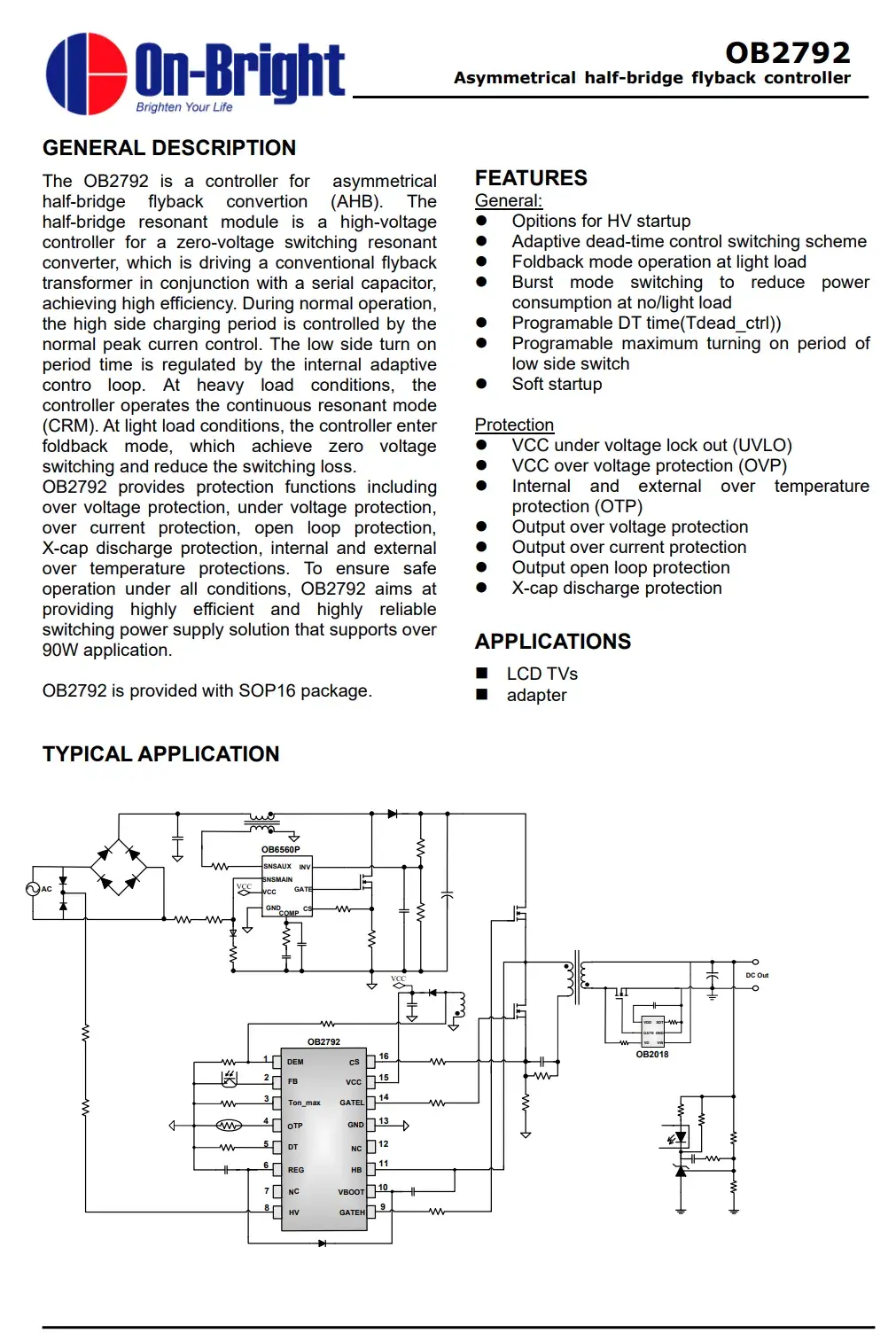
It supports over-voltage protection, under-voltage protection, over-current protection, open-loop protection, X capacitor discharge protection, and internal and external over-temperature protection. It is designed to provide an efficient and reliable switching power supply solution for applications requiring 90W and above.
Richtek
RT7795
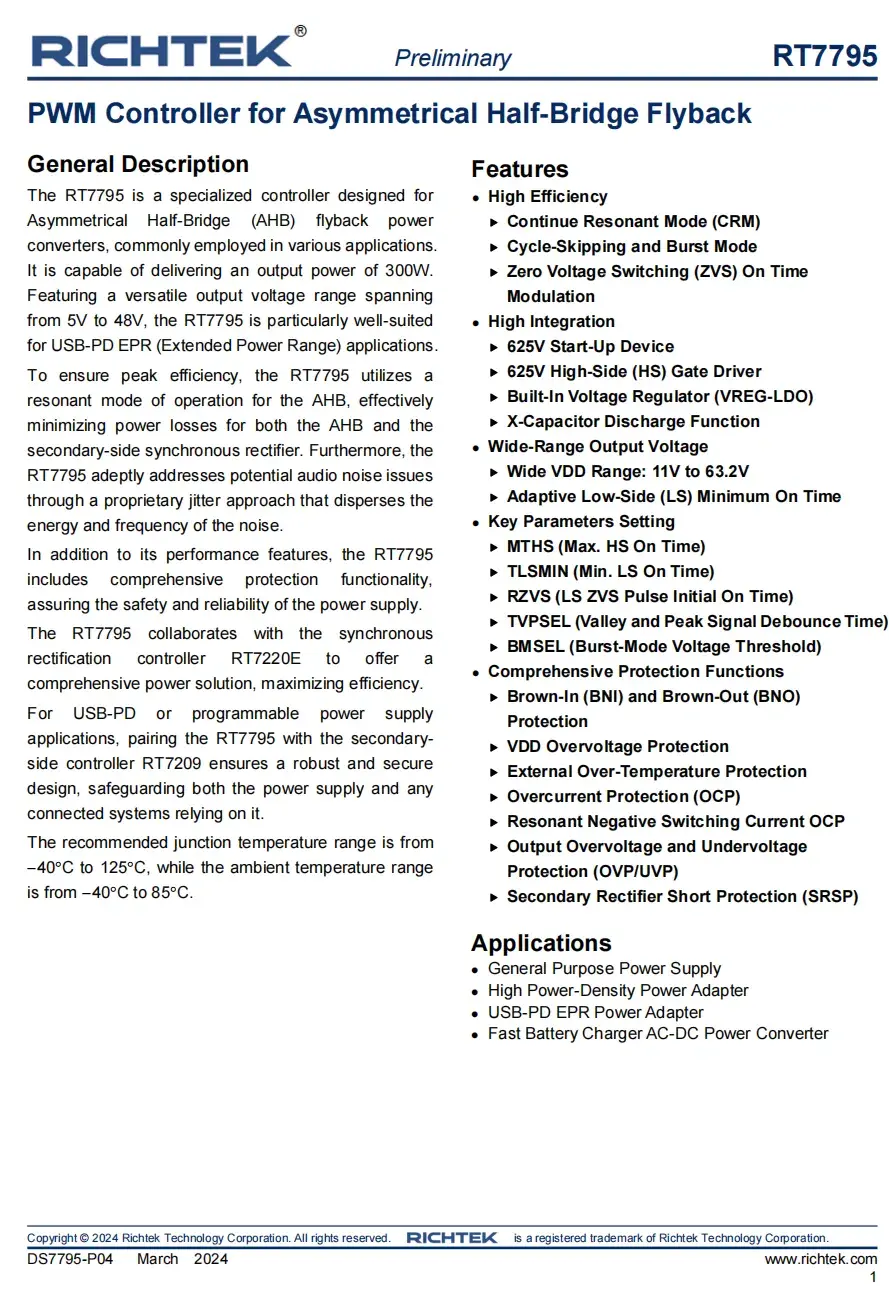
RT7795 is a controller launched by Richtek specially designed for asymmetric half-bridge (AHB) conversion power supply. It has a built-in 625V high-voltage starting device, an output power of up to 300W, supports 5-48V output voltage, and has a built-in X-capacitor discharge. It adopts a continuous resonant operation mode, which can effectively reduce the power loss of AHB and the secondary-side synchronous rectifier. It has multiple built-in protection mechanisms and adopts WQFN-24L package, which is suitable for high-power GaN fast-charging power supply design.
In addition to this AHB controller, Richtek has also launched a number of chips for SR, PFC, and other topologies.
Summary of ChargerLAB
With its advantages in power density, efficiency, cost, etc., the AHB controller has gradually become one of the mainstream choices in fast-charging product design. Compared with the traditional flyback topology, the AHB architecture has significant advantages in energy conversion and loss control and is particularly suitable for high power density and cost-effective application scenarios. Its innovations in topology and control strategy enable fast-charging products to achieve higher power output while also being more efficient and reliable.
Major manufacturers are actively launching their own AHB controller products. These products continue to innovate in technology and demonstrate strong competitiveness in practical applications. These products improve the efficiency and reliability of power supply systems and make it possible to simplify and miniaturize power supply design, meeting the demand for efficient and compact power supply solutions. Combined with its characteristics, the AHB controller is suitable for high-power e-bike chargers. In the future, as the technology matures further and the market continues to expand, AHB controllers are expected to demonstrate their unique value in more fields and promote the fast-charging industry to a higher level.
Related Articles:
1. Twenty Five PD3.1 Protocol Chips and Their Manufacturers: A ChargerLAB Analysis
2.30 PD3.1 Protocol Chips and Their 11 Manufacturers: A ChargerLAB Analysis
3. Innovating Power: Exploring Six 140W PD3.1 Power Bank PMICs

